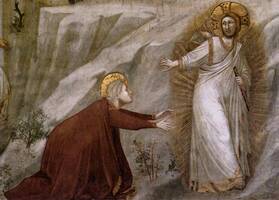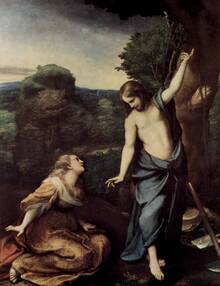St Mary Magdalene
Follower of Jesus; present at his Crucifixion & burial; first to witness the empty tomb
Dates of birth & death unknown
Thought to have died in Saint-Maximin-la-Sainte-Baume, in the south of France.
Feast day - 22nd July
Marijke, from the Netherlands chose Mary Magdalen as her Incredible Saint ![]() in Dutch
in Dutch ![]()
"When I became a Catholic I chose St Mary Magdalene as my patron saint because she really was focused totally on God, on Jesus, and she didn't care what other people thought about it, she just completely lived for Him. She helped me to keep focused on Jesus and to completely live only for Him in my day to day life."
Apostle of Hope
Catechesis by Pope Francis 
General Audience, Wednesday 17 May 2017 - in Arabic, Croatian, English, French, German, Italian, Polish, Portuguese & Spanish
"Dear brothers and sisters, good morning!
In these weeks our reflection is moving in the orbit, so to speak, of the paschal mystery. Today we meet the one who, according to the Gospels, was the first to see Jesus resurrected: Mary Magdalene. The Sabbath rest had just ended. On the day of the Passion, there had not been time to complete the funeral rites; that is why, in that dawn full of sadness, the women went to Jesus’ tomb with perfumed oils. She was the first to arrive: Mary of Magdala, one of the disciples who had accompanied Jesus from Galilee, putting herself at the service of the nascent Church. In her journey to the sepulchre is reflected the fidelity of so many women who for years are devoted to the footpaths of cemeteries, in memory of someone who is no longer with them. The most authentic bonds are not even broken by death: there are those who continue to love, even if the person loved is gone forever.
The Gospel (cf Jn 20, 1-2, 11-18) describes the Magdalene, immediately pointing out that she was not a woman given easily to enthusiasm. In fact, after the first visit to the sepulchre, she returns disappointed to the place where the disciples were hiding; she reports that the stone has been moved from the entrance to the sepulchre, and her first hypothesis is the simplest one that can be formulated: someone must have stolen Jesus’ body. Thus the first announcement that Mary brings is not that of the resurrection, but of a theft committed by unknown people while all Jerusalem was asleep.
The Gospels then recount a second journey of the Magdalene to Jesus’ sepulchre. She was stubborn! She went, she returned ... because she was not convinced! This time her pace is slow, very heavy. Mary suffers twice as much: firstly for the death of Jesus, and then for the inexplicable disappearance of his body.
It is as she is stooping near the tomb, her eyes full of tears, that God surprises her in the most unexpected way. John the Evangelist underlines how persistent her blindness is: she does not notice the presence of the two angels who question her, and she does not even become suspicious seeing the man behind her, whom she thinks is the custodian of the garden. And instead she discovers the most staggering event in human history when finally she is called by her name: “Mary!” (v 16).
How beautiful it is to think that the first apparition of the Risen Lord — according to the Gospels — took place in such a personal way! There is someone who knows us, who sees our suffering and disappointment, and who is moved by us, and calls us by our name. It is a law that we find engraved in many pages of the Gospel. Around Jesus there are many people who are seeking God; but the most prodigious reality is that, long before that, it is first of all God who is concerned for our life, who wants to raise it up, and to do this He calls us by name, recognizing the personal face of each of us. Each man is a story of love that God writes on this earth. Each one of us is a story of God's love. God calls each of us by our own name: He knows us by name, He looks at us, He awaits us, He forgives us, He is patient with us. Is this true or not true? Each of us has this experience.
And Jesus calls her “Mary!”: the revolution of her life, the revolution destined to transform the existence of every man and woman, begins with a name which resounds in the garden of the empty sepulchre. The Gospels describe for us Mary’s happiness: the resurrection of Jesus is not a joy given with a dropper, but a waterfall that cascades over the whole of life. Christian existence is not woven with soft happiness, but with waves that sweep over everything. Try to think, you as well, in this instant, with the baggage of disappointments and failures that each of us bear in our hearts, that there is a God close to us who calls us by name and tells us: ‘Arise, stop weeping, because I have come to liberate you!” This is beautiful.
Jesus is not one who adapts himself to the world, tolerating that in it persist death, sadness, hatred, the moral destruction of people.... Our God is not inert, but our God — I allow myself the word — is a dreamer: He dreams of the transformation of the world, and He has realized it in the mystery of the Resurrection.
Mary would like to embrace her Lord, but He is now oriented towards the heavenly Father, whereas she is sent to bring the announcement to her brothers. And so this woman, who before encountering Jesus was a prey to the evil one (cf Lk 8, 2), has now become apostle of the new and greatest hope. May her intercession help us also to live this experience: in the hour of weeping, and in the hour of abandonment, to hear the Risen Jesus who calls us by name, and with a heart full of joy to go and announce: “I have seen the Lord!” (v 18). I have changed my life because I have seen the Lord! Now I am different from before, I am another person. I have changed because I have seen the Lord. This is our strength and this is our hope. Thank you."
From a homily on the Gospels by St Gregory the Great
"When Mary Magdalene came to the tomb and did not find the Lord’s body, she thought it had been taken away and so informed the disciples. After they came and saw the tomb, they too believed what Mary had told them. The text then says: The disciples went back home, and it adds: but Mary wept and remained standing outside the tomb.
We should reflect on Mary’s attitude and the great love she felt for Christ; for though the disciples had left the tomb, she remained. She was still seeking the one she had not found, and while she sought she wept; burning with the fire of love, she longed for him who she thought had been taken away. And so it happened that the woman who stayed behind to seek Christ was the only one to see him. For perseverance is essential to any good deed, as the voice of truth tells us: Whoever perseveres to the end will be saved.
At first she sought but did not find, but when she persevered it happened that she found what she was looking for. When our desires are not satisfied, they grow stronger, and becoming stronger they take hold of their object. Holy desires likewise grow with anticipation, and if they do not grow they are not really desires. Anyone who succeeds in attaining the truth has burned with such a great love. As David says: My soul has thirsted for the living God; when shall I come and appear before the face of God? And so also in the Song of Songs the Church says: I was wounded by love; and again: My soul is melted with love.
Woman, why are you weeping? Whom do you seek? She is asked why she is sorrowing so that her desire might be strengthened; for when she mentions whom she is seeking, her love is kindled all the more ardently.
Jesus says to her: Mary. Jesus is not recognised when he calls her “woman”; so he calls her by name, as though he were saying: Recognise me as I recognise you; for I do not know you as I know others; I know you as yourself. And so Mary, once addressed by name, recognises who is speaking. She immediately calls him rabboni, that is to say, teacher, because the one whom she sought outwardly was the one who inwardly taught her to keep on searching."



